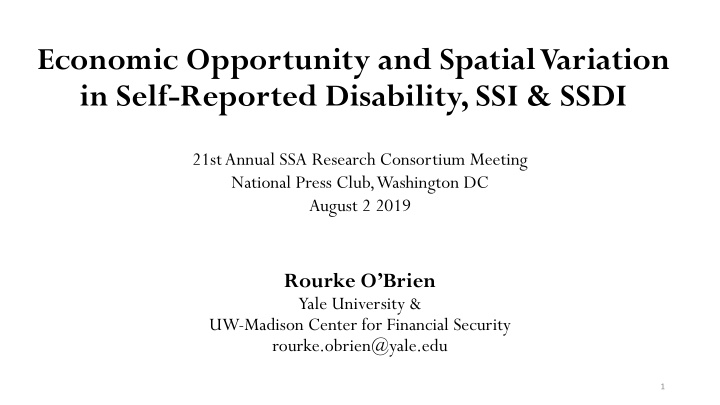



Economic Opportunity and Spatial Variation in Self-Reported Disability, SSI & SSDI 21st Annual SSA Research Consortium Meeting National Press Club, Washington DC August 2 2019 Rourke O’Brien Yale University & UW-Madison Center for Financial Security rourke.obrien@yale.edu 1
Key research questions 1. Is there an association between local area economic opportunity and disability , net of sociodemographic and economic characteristics? 2. Does local area economic opportunity moderate the relationship between unemployment and disability? 2
What is economic opportunity? Economic Opportunity = Intergenerational Economic Mobility A measure of the extent to which children born to low-income families move up the income distribution in adulthood. Distinct from ‘standard’ economic measures such as unemployment, labor force participation, inequality, material deprivation, poverty, etc. 3
Geography of opportunity: Evidence from Chetty et al. Map shows expected mean rank in national income distribution for children born to parents at the 25 th income percentile Chetty and Hendren (2015), based on income tax data 4
Economic opportunity & health Growing literature linking economic opportunity and health Health as determinant of economic mobility/opportunity • Medicaid (O’Brien & Robertson); Birthweight (Robertson & O’Brien); Pollution (O’Brien et al; Manduca & Sampson) Opportunity as a determinant of health • Mobility context and risky health behaviors in adolescents (Venkataramani et al); White mortality (O’Brien et al); Black-White Mortality Gap (O’Brien et al) • Health impacts of policies that shift opportunity: DACA (Venkataramani et al), Affirmative Action Bans (Venkataramani et al) 5
Economic opportunity & health 6
Key research questions 1. Is there an association between local area economic opportunity and disability net of sociodemographic and economic characteristics? 2. Does local area economic opportunity moderate the relationship between unemployment and disability? 7
Data and analytic strategy Unit of Analysis : County (n=2,764) Model: OLS Cross-section Predictor: Opportunity Measure Outcomes (pooled 2013-2017): • Self-reported Disability Male, Female (Age 35-64) • SSI Rate (Age 18-64) • SSDI Rate (Age 18-64) Covariates (pooled 2013-2017): Unemployment rate, median household income, education, labor force participation total population, age distribution, racial composition, poverty, and income inequality (gini). 8
Opportunity & Self-reported disability, Males 35-64 9
Opportunity & Self-reported disability, Females 35-64 10
Outcome: Self-reported disability Notes: Model 2 also adjusts for total population, age distribution, racial composition and income inequality (Gini coefficient). 11
Outcome: SSDI rate (18-64) Notes: Model 2 also adjusts for total population, age distribution, racial composition and income inequality (Gini coefficient). 12
Outcome: SSI rate (18-64) Notes: Model 2 also adjusts for total population, age distribution, racial composition and income inequality (Gini coefficient). 13
Key Research Questions 1. Is there an association between local area economic opportunity and disability net of sociodemographic and economic characteristics? 2. Does local area economic opportunity moderate the relationship between unemployment and disability? 14
Unemployment & SSDI During Great Recession Low Opportunity Counties Mid Opportunity Counties High Opportunity Counties 15
Data and Analytic Strategy Unit of Analysis: County-Year (2005-2017) Model: Two-way FE (county and year) Predictor : Unemployment (time-varying) X Opportunity Measure Outcomes (annual): • Self-reported Disability (Age 35-64) • SSI Rate (Age 18-64) • SSDI Rate (Age 18-64) Time-varying Covariates (annual): Median household income, education, labor force participation total population, age distribution, racial composition, household composition, homeownership, poverty and income inequality (gini). 16
Opportunity as Moderator of Unemployment-Disability Relationship 17
Conclusions Areas with higher levels of economic opportunity have lower rates of disability and disability assistance, net of standard covariates. Local area economic opportunity moderates relationship between unemployment and disability. • Increasing unemployment drives greater demand for disability in low opportunity areas relative to high opportunity areas Implications for understanding drivers of demand for disability during economic contractions. 18
With Appreciation… Social Security Administration Center for Financial Security, UW-Madison Collaborators: Nathan Seltzer (UW-Madison), Tiffany Neman (UW-Madison) 19
Economic Opportunity and Spatial Variation in Self- Reported Disability and Receipt of SSI & SSDI 21st Annual SSA Research Consortium Meeting National Press Club, Washington DC August 2 2019 Rourke O’Brien Yale University & UW-Madison Center for Financial Security rourke.obrien@yale.edu 20
Recommend
More recommend